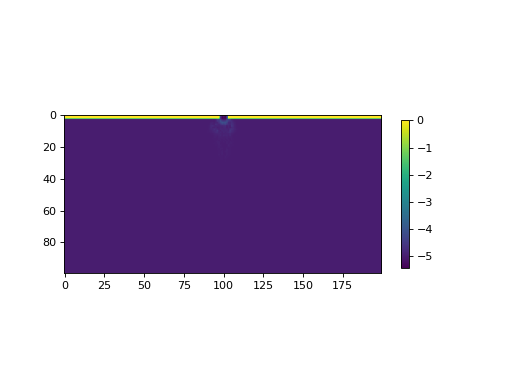User Guide¶
This is the BMI implementation of the pyDeltaRCM model.
Examples¶
Basic run¶
from BMI_pyDeltaRCM import BmiDelta
delta = BmiDelta()
delta.initialize()
for _ in range(3):
delta.update()
Three timesteps produces only a small mouth bar deposit.
import matplotlib.pyplot as plt
fig, ax = plt.subplots()
im = ax.imshow(delta.get_value('sea_bottom_surface__elevation'))
plt.colorbar(im, ax=ax, shrink=0.5)
plt.show()

After you are finished with the model, you can clean up (save any outputs, release memory) with:
delta.finalize()
Hint
Pass a path to a YAML file to initialize to use a configuration file to set up the BmiDelta model.
mdl.initialize(filename='input_configuration.yml')
Changing runtime values¶
Change the bedload fraction input on each timestep.
delta = BmiDelta()
delta.initialize()
for i in range(3):
delta.set_value('channel_exit_water_sediment~bedload__volume_fraction', (i/2))
delta.update()
fig, ax = plt.subplots()
im = ax.imshow(delta.get_value('sea_bottom_surface__elevation'))
ax.set_title('end f_bedload: {0}'.format(delta._delta.f_bedload))
plt.colorbar(im, ax=ax, shrink=0.5)
plt.show()

delta.finalize()
Input Parameters¶
The following CSDMS standard variable names are supported in an input YAML configuration file.
‘model_output__out_dir’
‘model_grid__length’
‘model_grid__width’
‘model_grid__cell_size’
‘land_surface__width’
‘land_surface__slope’
‘model__max_iteration’
‘water__number_parcels’
‘channel__flow_velocity’
‘channel__width’
‘channel__flow_depth’
‘sea_water_surface__mean_elevation’
‘sea_water_surface__rate_change_elevation’
‘sediment__number_parcels’
‘sediment__bedload_fraction’
‘sediment__influx_concentration’
‘model_output__opt_eta_figs’
‘model_output__opt_stage_figs’
‘model_output__opt_depth_figs’
‘model_output__opt_discharge_figs’
‘model_output__opt_velocity_figs’
‘model_output__opt_eta_grids’
‘model_output__opt_stage_grids’
‘model_output__opt_depth_grids’
‘model_output__opt_discharge_grids’
‘model_output__opt_velocity_grids’
‘model_output__opt_time_interval’
‘coeff__surface_smoothing’
‘coeff__under_relaxation__water_surface’
‘coeff__under_relaxation__water_flow’
‘coeff__iterations_smoothing_algorithm’
‘coeff__depth_dependence__water’
‘coeff__depth_dependence__sand’
‘coeff__depth_dependence__mud’
‘coeff__non_linear_exp_sed_flux_flow_velocity’
‘coeff__sedimentation_lag’
‘coeff__velocity_deposition_mud’
‘coeff__velocity_erosion_mud’
‘coeff__velocity_erosion_sand’
‘coeff__topographic_diffusion’
‘basin__opt_subsidence’
‘basin__maximum_subsidence_rate’
‘basin__subsidence_start_timestep’
‘basin__opt_stratigraphy’
Runtime Parameters¶
The following CSDMS standard variable names are supported to be viewed and changed during model runtime (using get_value and set_value).
Key in brackets indicates the underlying pyDeltaRCM DeltaModel attribute that is viewed/changed via the BMI.
‘channel_exit_water_flow__speed’ [‘u0’]
‘channel_exit_water_x-section__width’ [‘N0_meters’]
‘channel_exit_water_x-section__depth’ [‘h0’]
‘sea_water_surface__mean_elevation’ [‘H_SL’]
‘sea_water_surface__rate_change_elevation’ [‘SLR’]
‘channel_exit_water_sediment~bedload__volume_fraction’ [‘f_bedload’]
‘channel_exit_water_sediment~suspended__mass_concentration’ [‘C0_percent’]
‘sea_water_surface__elevation’ [‘stage’]
‘sea_water__depth’ [‘depth’]
‘sea_bottom_surface__elevation’ [‘eta’]